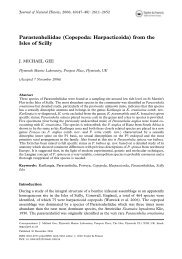An Updated Classification of the Recent Crustacea
An Updated Classification of the Recent Crustacea
An Updated Classification of the Recent Crustacea
Create successful ePaper yourself
Turn your PDF publications into a flip-book with our unique Google optimized e-Paper software.
cerning barnacle evolution (Schram and Høeg,<br />
1995) reveals mostly that we still have much to<br />
learn about <strong>the</strong> relationships <strong>of</strong> <strong>the</strong> various groups<br />
<strong>of</strong> maxillopods.<br />
SUPERORDER ACROTHORACICA<br />
For this group, we have followed <strong>the</strong> classification<br />
<strong>of</strong> Newman (1996), where acrothoracicans are divided<br />
among two orders, Pygophora (with two<br />
families) and Apygophora (with a single family).<br />
SUPERORDER RHIZOCEPHALA<br />
Our classification <strong>of</strong> this group follows Høeg<br />
(1992), Høeg and Rybakov (1992), Høeg and Lützen<br />
(1993, 1996), Huys (1991), and Lützen and<br />
Takahashi (1996). Thus, we treat <strong>the</strong> Rhizocephala<br />
as an infraclass that contains two orders, Kentrogonida<br />
(with three families) and Akentrogonida<br />
(with six families), although <strong>the</strong>re is concern that<br />
one or both <strong>of</strong> <strong>the</strong>se orders may be paraphyletic<br />
(see Høeg and Lützen, 1993). Jensen et al. (1994a,<br />
b) supported monophyly <strong>of</strong> <strong>the</strong> Akentrogonida on<br />
<strong>the</strong> basis <strong>of</strong> details <strong>of</strong> <strong>the</strong> lattice organs.<br />
Within <strong>the</strong> Kentrogonida, concerning <strong>the</strong> issue <strong>of</strong><br />
authorship <strong>of</strong> <strong>the</strong> families Peltogastridae and Sacculinidae<br />
(which we had earlier credited to Boschma),<br />
W. Vervoort writes (pers. comm.): ‘‘. . . both<br />
<strong>the</strong> families Peltogastridae and Sacculinidae must<br />
be ascribed to Lilljeborg, 1860. This has been duly<br />
checked. Boschma lived [from] 1893–1976 and<br />
cannot possibly be <strong>the</strong> author <strong>of</strong> <strong>the</strong>se two families.<br />
Holthuis and I consulted Lilljeborg’s 1860 publication,<br />
a copy <strong>of</strong> which is in our library; <strong>the</strong>re is<br />
not a shadow <strong>of</strong> a doubt concerning his authorship.’’<br />
The family Sylonidae (Sylidae in Bowman<br />
and Abele) has been subsumed within <strong>the</strong> Clistosaccidae<br />
Boschma, which is now included in <strong>the</strong><br />
Akentrogonida (J. Høeg, pers. comm.).<br />
Within <strong>the</strong> Akentrogonida, three new families<br />
(Duplorbidae, Mycetomorphidae, and Thompsoniidae)<br />
were described by Høeg and Rybakov (1992)<br />
and one new family (Polysaccidae) was added by<br />
Lützen and Takahashi (1996). The Chthamalophilidae<br />
is recognized as a valid family (also following<br />
Høeg and Rybakov, 1992), and, as noted above,<br />
<strong>the</strong> Clistosaccidae was transferred into <strong>the</strong> Akentrogonida<br />
from <strong>the</strong> Kentrogonida.<br />
SUPERORDER THORACICA<br />
Although few new extant families have been suggested<br />
since 1982, <strong>the</strong>re have been significant rearrangements<br />
<strong>of</strong> <strong>the</strong> cirripedes (or attempts to rearrange<br />
<strong>the</strong>m) by workers using morphological and<br />
molecular data. Perhaps <strong>the</strong> most comprehensive is<br />
<strong>the</strong> cladistic study by Glenner et al. (1995), who<br />
concluded that many currently recognized groups<br />
appear to be paraphyletic, including <strong>the</strong> groups that<br />
appear in our classification under <strong>the</strong> headings ‘‘Lepadomorpha’’<br />
and ‘‘Pedunculata.’’ However, Glenner<br />
et al. (1995) also noted that ‘‘we have far to go<br />
before a new taxonomy can emerge’’ and suggested<br />
<strong>the</strong> continued use <strong>of</strong> such commonly used terms as<br />
‘‘lepadomorphs’’ or ‘‘pedunculates’’ as long as<br />
workers understand that <strong>the</strong>se are groupings more<br />
<strong>of</strong> convenience than <strong>of</strong> common descent. We are<br />
not in agreement with this philosophy and would<br />
prefer to recognize taxa that reflect common descent,<br />
but in this group, it is apparent that we are<br />
not yet at <strong>the</strong> point where we know which clades<br />
are valid.<br />
For <strong>the</strong> most part, we have followed <strong>the</strong> classification<br />
<strong>of</strong> <strong>the</strong> Thoracica given by Newman (1996).<br />
Thus, we are recognizing <strong>the</strong> order Pedunculata (an<br />
old name that was previously thought to lack validity<br />
but that Newman (1996) feels is a natural<br />
assemblage and thus has resurrected) as containing<br />
four suborders. Some <strong>of</strong> <strong>the</strong> names in this order<br />
(e.g., Heteralepadomorpha, Iblomorpha, Scalpellomorpha)<br />
are credited to Newman (1987), although<br />
it is clear that <strong>the</strong>se higher taxon names are<br />
based on older works, which perhaps should be<br />
credited as <strong>the</strong> taxon author and date if we were<br />
to closely adhere to ICZN article 50.3.1 as extended<br />
to higher taxa. Many <strong>of</strong> <strong>the</strong> families now treated<br />
in <strong>the</strong>se four suborders were elevated from subfamily<br />
status by Newman (1987). For example, within<br />
<strong>the</strong> Scalpellomorpha, only <strong>the</strong> family Scalpellidae<br />
Pilsbry is also found in <strong>the</strong> Bowman and Abele<br />
(1982) classification. Within <strong>the</strong> resurrected order<br />
Sessilia (see Newman, 1987; Buckeridge, 1995), <strong>the</strong><br />
brachylepadomorph family Neobrachylepadidae<br />
was described by Newman and Yamaguchi (1995)<br />
and <strong>the</strong> verrucomorph family Neoverrucidae was<br />
described by Newman (1989, in Newman and Hessler,<br />
1989:268; see also Newman, 1989). Within<br />
<strong>the</strong> Balanomorpha, Buckeridge (1983) added <strong>the</strong><br />
superfamily Chionelasmatoidea, containing <strong>the</strong> single<br />
family Chionelasmatidae. Suggestions for evolutionary<br />
radiations within <strong>the</strong> Balanomorpha were<br />
presented by Yamaguchi and Newman (1990). A<br />
recent molecular analysis <strong>of</strong> several thoracican taxa<br />
(Harris et al., 2000) suggests that <strong>the</strong> sessile barnacles<br />
are monophyletic but that <strong>the</strong> pedunculate<br />
forms (our Pedunculata) may not be.<br />
SUBCLASS TANTULOCARIDA<br />
The Tantulocarida, bizarre parasites <strong>of</strong> o<strong>the</strong>r deepsea<br />
crustaceans, were known as early as <strong>the</strong> beginning<br />
<strong>of</strong> <strong>the</strong> 20th century (reviewed by Huys, 1990e,<br />
1991; Boxshall, 1991, 1996) but were recognized<br />
as a distinct class <strong>of</strong> <strong>Crustacea</strong> only in 1983<br />
(Boxshall and Lincoln, 1983), just too late for inclusion<br />
by Bowman and Abele (1982). They have<br />
since been relegated to a subclass or infraclass within<br />
<strong>the</strong> Thecostraca or have been proposed as <strong>the</strong><br />
sister group to <strong>the</strong> Thecostraca within <strong>the</strong> Maxillopoda<br />
(e.g., Boxshall and Huys, 1989a; Boxshall,<br />
1991; Huys et al., 1993). Our classification follows<br />
that <strong>of</strong> Huys (1990e) (see also Huys, 1991, where<br />
two families are also described). Discussions <strong>of</strong> <strong>the</strong><br />
relationships <strong>of</strong> tantulocaridans (all <strong>of</strong> which lack<br />
Contributions in Science, Number 39 Rationale 23











